Age II: The Conquerors - The Aztecs Showcase
Our fourth installment of Age II: Conquerors' civilizations takes a look at the Aztecs.
The Aztecs Showcase
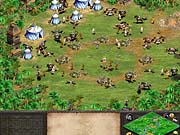
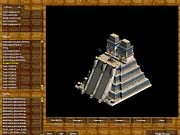
The gameplay statistics of the Aztecs match up well with the other infantry-heavy civilizations, like the Japanese, Celts, and Teutons. The Aztecs, as they were in history, are ferocious warriors on the ground, and they also boast incredibly powerful monks, who draw great strength from their powerful faith. Over the next few pages, we'll take a brief look at the history of the Aztecs, as well as their unique advantages in the Age II expansion pack.
A Brief Aztec History
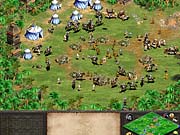
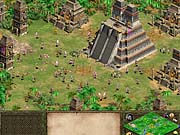
The Aztecs had migrated to central Mexico, which had once been the cradle of the great Toltec civilization. Amidst the ruins of the Toltec empire, the Aztecs established their first city on one of the islands of the great central lake of Texcoco. The Aztecs excelled at warfare, and they quickly established dominance over the central lake, gaining more power and subjugating the rival tribes of the area. Through strategic alliances with other powerful city-states, the Aztecs increased their empire's reach. Under the leadership of the Aztec leader Itzcoatl and, later, his successor Montezuma I, the Aztecs crushed their neighbors and established themselves as the ruling power of central Mexico.
The Aztecs used the technological knowledge of many civilizations before it, such as the Mayan's and the Olmec's. Their calendar, for example, was based on the Mayan's. The Aztecs did not have iron, and they had no use for metal coins. In fact, their economy used such items as cacao beans and corn as the units of monetary exchange. What was distinctive about their culture wasn't their technological achievements, which were impressive, but their religious rituals, which called for plentiful and massive human sacrifices. The Aztecs believed that the sun god required awesome amounts of human sacrifices in order to empower him to battle the evil gods and to rise each day to give new life to the land. To that end, human sacrifices were conducted regularly and on alarmingly massive scales. Often, the human sacrifice was stretched atop a stone slab at the top of a pyramid. An Aztec priest would then carve out the still-beating heart of the victim and then hurl it into a great sacred fire. Thousands of humans would be sacrificed each day, and according to legend, 80,000 people were sacrificed to the sun god in 1487 to dedicate a rebuilt temple in Tenochtitlan. To fuel this incredible need for human sacrifices (for the Aztecs believed that such frequent sacrifices were vital to their continued existence), the Aztecs conducted many "garland wars" against rival tribes and neighbors, capturing many prisoners of war to use as sacrifices. These frequent wars and the usage of neighbors as sacrifices would prove to be the Aztec empire's downfall.
In 1519, the Spanish landed on Mexican shores, in search of gold. Led by Hernan Cortez, they recruited many of the discontented neighbors of the Aztecs and marched on Tenochtitlan. Although vastly outnumbered by the Aztecs, the Spanish were fortunate in that they had brought diseases with them from the Old World, which decimated the native peoples. Moreover, they had the help of many indigenous allies, who were eager to exact revenge on the Aztecs. In 1521, Tenochtitlan fell after protracted fighting between the Aztecs and the Spanish, and the rest of the Aztec empire soon followed. The bloody reign of the Aztecs was destroyed, signaling the end of the great Meso-American civilizations.
Aztec Bonuses
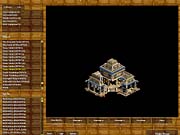
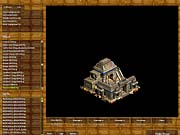
Street says, "Between the two Meso-American civs, the Mayans are more economically oriented, while the Aztecs are more military oriented." To that end, the Aztec player produces troops 15 percent faster than normal. All infantry, cavalry, and archers can be churned out at a faster rate. Not only does this make it easier to field an army for rushing, but it also means you have a slightly better chance of fighting off an unexpected attack. With the Garland Wars technology in the late game and the discovery of the unique jaguar warrior, this speedier troop production gives the Aztecs a distinct advantage in wartime production. While this bonus doesn't help in actual battle, it does give the Aztecs a huge production bonus, meaning more troops can be pumped out in less time.
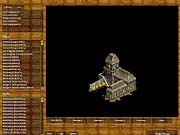
Monks aren't always a viable part of a player's strategy, but with the increase in relic gold production and the introduction of new monastery technologies, you'll have more reason than ever before to have at least a few monks in your army. Says Street, "Aztecs are probably the best monk civilization in the game. Every time the Aztecs research one of the ten monastery upgrades, their monks gain 5 HP. That means that a fully upgraded Aztec monk (keep in mind how much it costs to get there) has a whopping 95 hit points! Aztecs are great at monk rushes and also [can] bring their monks along into combat to heal their infantry and convert the occasional paladin or conquistador." This Aztec bonus definitely makes the monk a more viable member of the Aztec army.
Villagers Can Carry +5 More Resources
The last Aztec bonus is a modest one for their villagers, and it aids in resource gathering. Aztec villagers, whether fishing, hunting, farming, mining, or performing other duties, can carry five more resource units than other civilizations' villagers. The bonus is helpful early on when you start out, when resources are at a premium and you can't afford to lay down too many mills or lumber camps as excess drop sites for resources.
Team Bonus: 33 Percent More Relic Gold Production
In team games, the Aztecs have a great bonus that gives them more gold when they hold relics. Relics already produce more gold in the expansion pack, making them a more viable source of income, but the Aztec-held relics generate 33 percent more gold.
Aztec Units and Technology
It is in their unique unit and unique technology that the Aztecs' infantry prowess really comes to the fore. Their unique unit is the jaguar warrior, which is an anti-infantry infantry unit. In addition, they also gain a new infantry type, the eagle warrior.
Eagle Warriors
In our previous showcase of the Mayans (link to preview), we introduced the eagle warriors, a new breed of infantry that are unique to the two Meso-American civilizations. The reason these eagle warriors were added was that the New World civilizations lack horses and thus any mounted units such as cavalry and cavalry archers. To make up for the loss, the designers created a foot soldier who could move almost as quickly as a horse-mounted unit, both to act as a quick scout and to kill enemy archers. The Aztecs share the eagle warriors with the Mayans. This unit is a Castle Age unit, and it has an upgraded version that is stronger. The role of this unit is the same as a light cavalry unit's.
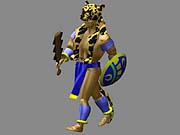
This is the Aztec's unique unit: a powerful foot soldier who can tear through enemy infantry with ease. A good overall infantry unit, the jaguar warrior has more hit points than a champion, but it inflicts less damage. However, against infantry, it gets +10 attack bonus. Says Street, "The jaguar warrior is a foot-cataphract. The jaguar does 12 points of damage to most units, with a +10 bonus against infantry. Add +4 for blacksmith upgrades and another +4 for Garland Wars, and the Aztecs have a cheap unit that can do 30 points of damage to enemy infantry. That's more [damage] than a Byzantine cataphract [deals], though [the jaguar warrior has] fewer hit points. Jaguar warriors do not fear champions, woad raiders, berserks, eagle warriors, or huskarls. They are about evenly matched with samurai and Teutonic knights. If you are playing against Aztecs, you must bring in cavalry or archers to deal with the jaguar warriors." Of course, that's where the fleet-footed eagle warriors come in.
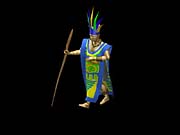
The unique technology for the Aztecs further strengthens their infantry, giving them a +4 attack bonus. At the Ensemble Studios office, it is considered the best unique technology. Says Street, "Garland Wars improves the attack of pikemen, champions, eagle warriors, and jaguar warriors by +4. This means an Aztec eagle warrior does 9+8 damage, and a champion does 13+8 damage fully upgraded. That is a lot of power packed into a unit that costs 60 food and 20 gold! Of all the unique technologies in the expansion pack, Garland Wars is perhaps the one that you cannot live without... The bad news for the Aztecs is that it is an Imperial Age upgrade that requires a castle, so the Aztecs really aren't at their most deadly until that stage of the game."
Aztec Strategies
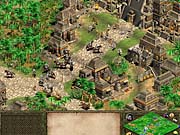
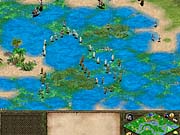
On island maps, the Aztecs have no naval bonuses, so they are best served by trying to win with land invasions. That, though, requires well-defended transports, which could be another weak link in the Aztec army. Still, the Aztecs have undeniable merits.
Street concludes, "The Aztecs are probably my favorite civilization, and I play them in one of three ways: monk rush with towers and archers for support; eagle warrior raiders to kill villagers in the Castle Age; or the full-on champion/jaguar warrior flood with the Garland Wars [tech]. Aztecs fear Byzantines, since they don't have much of an answer for the cataphract. They struggle more with horse civs than archer civs, since they can easily counter the latter with eagle warriors. If you like to tower-rush, build many walls, play with armies of Castle Age archers, or want a huge Imperial Age economy, then you may find that the Mayans fit your play style better. If you like monks, huge armies of cheap units, or want to see all enemy infantry obliterated, then you, like me, may play many games as an Aztec."
Thus ends our look at the fierce Aztec warriors of the New World. Join us in two weeks when we end our showcase of the Age II expansion civilizations with a look at the new Korean civilization.
Got a news tip or want to contact us directly? Email news@gamespot.com
Join the conversation